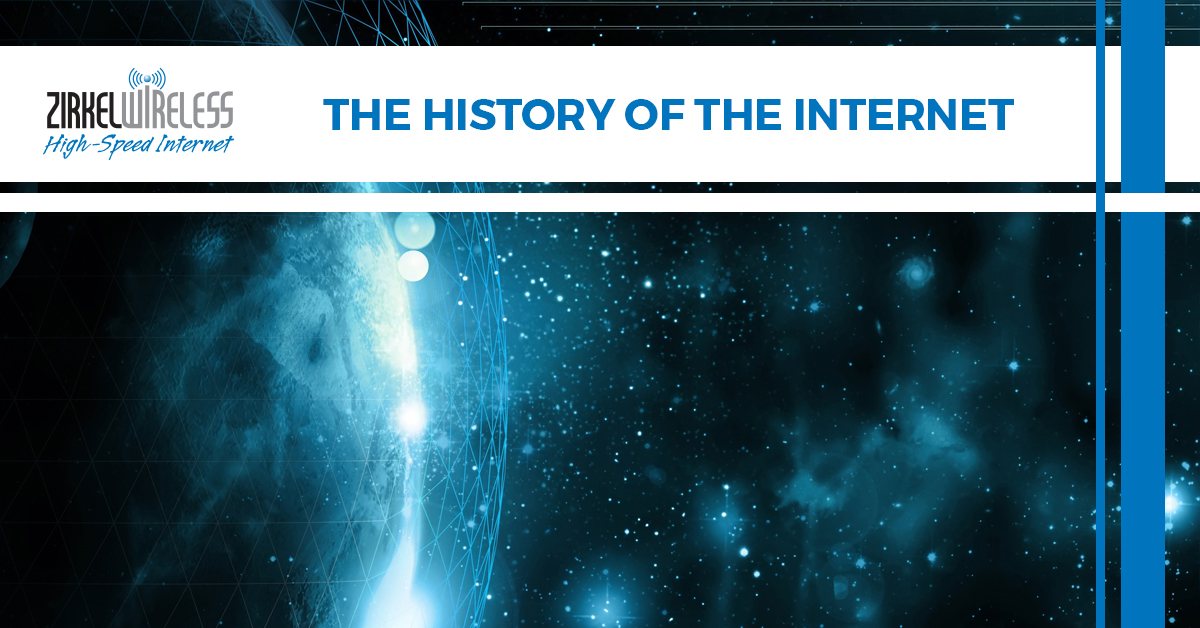Not too long ago, if you wanted to know the history of a subject, you would need to go to a library, find the correct section, and browse through countless books to even begin to understand a topic. Nowadays, you can find the history of literally anything simply by typing a search into Google.
From the history of National Pancake Day to the history of ancient building techniques used in the Roman Empire – a wealth of information is at our fingertips thanks to the internet. It becomes a bit of an Inception moment when you search the internet for “the history of the internet” – so we’re going to take the weird meta experience out of the situation and just tell you. As a leading Yampa Valley and Steamboat Springs internet provider, we pretty much revolve around the World Wide Web here at ZIRKEL Wireless. We want to share our passion by giving you some insight on just how we got to the place where we are today.

A Need For Wireless Internet Connections
Contrary to popular belief, Bill Gates did not actually invent the internet. So who did, and when? In the 1950s, America was engaged in the Cold War with the Soviet Union. After the Soviets launched the Sputnik satellite, Americans began to consider science, technology, and engineering as a more vital part of life.
The government began funding more science and technology programs, and schools added more advanced math and science courses in the hope that, as a society, we could hold our own in the Cold War. The biggest fear at the time was that the Soviet Union would wipe out America’s telephone network, disallowing for important long-distance communication. The solution came in the form of a widespread computer network that would allow for communication between Advanced Research Projects Agency (ARPA) computer terminals. The US Department of Defense, in particular, began developing the Advanced Research Projects Agency Network (ARPANET) project. The biggest impracticality of this was that ARPA computers were few and far between, they were incredibly expensive to make, and each computer was designed to serve one function of purpose. The struggle wasn’t so much communication between computers, but linking the computers in a way that would allow for remote access to the functions and capabilities of a different computer.
In 1965, an M.I.T. scientist developed a way to send data to other computers through a process called “packet switching.” This process broke data into smaller “packets” to be sent to it’s destination. This insured that each packet of data was sent through different routes, meaning that there was no one point of failure for data to be lost, nor a single point of entry for hackers to steal information.
The First Network
The first official ARPANET link came in 1969, and linked the University of California, Los Angeles (UCLA) with Stanford. Each computer was the size of a small house, and when communication was attempted, the system quickly crashed. However, within the year, the University of Utah and University of California, Santa Barbara were added to the network.
By 1981, over 200 more computers were added to the network – including computers in Hawaii, England, and Norway. Soon, the network got too big to communicate effectively. In the 1970s, a computer scientist solved this by creating a system of “mini-networks” that were localized, which could then communicate within a larger international network. We are moving closer to what we know as the internet today, but at this point, these systems were still used primarily for communicating and sending information.
The Internet As We Know It Today
In 1991, a Swiss computer scientist named Tim Berners-Lee introduced the World Wide Web – a web of stored information that was accessible to anyone who had access to the internet. The following year, a group of students at the University of Illinois created a browser that later became Netscape. This browser was user-friendly and allowed internet users to click links, use scrollbars, and view pictures and text on the same page for the first time ever.
That same year, Congress passed legislation allowing the internet to be used for commercial purposes, and internet shopping soon became a trend that would continue into the 21st century. Since that time, the internet has continued to grow and develop to have more and more information, and allow for new means of communication through email, social media, and other platforms. And the rest is history.
ZIRKEL Wireless Provides Affordable High-Speed Internet To Rural Colorado
While the internet was originally developed to thwart nuclear attacks from the Soviet Union, today it is more commonly used to binge watch Netflix shows, laugh at dog memes, share silly cat videos, and roll your eyes at your distant relatives on Facebook. And truthfully, that’s how we like it here at ZIRKEL Wireless.
The internet is full of ways to communicate and share experiences with the world around us, and providing that opportunity to Northwest Colorado is what we do best. We love the area we serve, and we go where the “big guys” won’t. Check out our internet service area map. If you are not sure if you’re in a coverage area, we’ll come out and check for free. If we don’t get a good signal, there’s no obligation to you. Contact us today to learn more about our wireless internet services in Steamboat Springs and surrounding areas!


